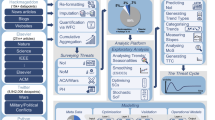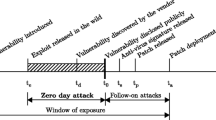Abstract
We present Soteria, a data processing pipeline for detecting multi-institution attacks. Soteria uses a set of machine learning techniques to detect future attacks, predict their future targets, and rank attacks based on their predicted severity. Our evaluation with real data from Canada-wide academic institution networks shows that Soteria can predict future attacks with 95% recall rate, predict the next targets of an attack with 97% recall rate, and detect attacks in the first 20% of their life span. Soteria is deployed in production and is in use by tens of Canadian academic institutions that are part of the CANARIE IDS project.













Similar content being viewed by others
References
Government Accountability Office (2021). Cyber Insurance-Insurers and policyholders face challenges in an evolving market, from https://www.gao.gov/assets/gao-21-477.pdf. Accessed Jan 2023
Akbanov M, Vassilakis V (2019) WannaCry ransomware: analysis of infection, persistence, recovery prevention and propagation mechanisms. J Telecommun Inf Tech 1:113–124
Accenture Security (2021). Ninth Annual cost of cybercrime study, from https://www.digitalmarketingcommunity.com/researches/ninth-annual-cost-of-cybercrime-research-2019. Accessed Jan 2023
Bilodeau H, Lari M, Uhrbach M (2019) Cyber security and cybercrime challenges of Canadian businesses in 2017, from https://www150.statcan.gc.ca/n1/pub/85-002-x/2019001/article/00006-eng.htm. Accessed Jan 2023
Dunning T, Friedman E (2014) In: Practical Machine Learning: Innovations in Recommendation. O’Reilly
CANARIE (2022). Canarie.ca, from https://www.canarie.ca/. Accessed Jan 2023
Zabarah S, Naman O, Salahuddin MA, Boutaba R, Al-Kiswany S (2023) Soteria: an approach for detecting multi-institution attacks. In: 2023 26th Conference on innovation in clouds, internet and networks and workshops (ICIN), pp 113–120. https://doi.org/10.1109/ICIN56760.2023.10073491
Udhayan J, Prabu M, Krishnan V, Anitha R (2009) Reconnaissance scan detection heuristics to disrupt the preattack information gathering. In: International conference on network and service security
Allen WH, Marin GA, Rivera LA (2005) Automated detection of malicious reconnaissance to enhance network security. Proceedings. IEEE SoutheastCon 2005:450–454. https://doi.org/10.1109/SECON.2005.1423286
Cao J, Jin Y, Chen A, Bu T, Zhang Z-L (2009) Identifying high cardinality internet hosts. In: IEEE INFOCOM 2009. https://doi.org/10.1109/INFCOM.2009.5061990
Kamiyama N, Mori T, Kawahara R (2007) Simple and adaptive identification of superspreaders by flow sampling. In: IEEE INFOCOM. https://doi.org/10.1109/INFCOM.2007.305
Liu Y, Chen W, Guan Y (2016) Identifying high-cardinality hosts from network-wide traffic measurements. IEEE Trans Dependable and Secure Comput 13(5):547–558. https://doi.org/10.1109/TDSC.2015.2423675
The Zeek Project (2022). conn.log - Book of ZEEK, from https://docs.zeek.org/en/master/logs/conn.html. Accessed Jan 2023
Cisco: networking, cloud, and cybersecurity solutions (2022). Snort, from https://www.snort.org. Accessed Jan 2023
The Open Information Security Foundation (OISF) (2022). Suricata, from https://www.suricata.io/. Accessed Jan 2023
Feng B (2021) Threat intelligence sharing: what kind of intelligence to share? Concordia, from https://www.concordia-h2020.eu/blog-post/threat-intelligence-sharing/. Accessed Jan 2023
Marathon Studios Inc (2016). AbuseIPDB - IP address abuse reports, from https://www.abuseipdb.com/. Accessed Jan 2023
Hispasec Sistemas (2004). virustotal.com, from https://www.virustotal.com/. Accessed Jan 2023
The MITRE Corporation (1999). CVE - common vulnerabilities and exposures, from https://cve.mitre.org/. Accessed Jan 2023
The MITRE Corporation (2006). CWE - common weakness enumeration, from https://cwe.mitre.org/. Accessed Jan 2023
Solarwinds (2023). Intrusion Detection Software, from https://www.solarwinds.com/security-event-manager/use-cases/intrusion-detection-software. Accessed Jan 2023
Skopik F, Settanni G, Fiedler R (2016) A problem shared is a problem halved: a survey on the dimensions of collective cyber defense through security information sharing. Comput Secur 60:154–176. https://doi.org/10.1016/j.cose.2016.04.003
Settanni G, Skopik F, Shovgenya Y, Fiedler R, Carolan M, Conroy D, Boettinger K, Gall M, Brost G, Ponchel C, Haustein M, Kaufmann H, Theuerkauf K, Olli P (2017) A collaborative cyber incident management system for European interconnected critical infrastructures. J Inf Secur Appl 34:166–182. https://doi.org/10.1016/j.jisa.2016.05.005
Hochreiter S, Schmidhuber J (1997) Long short-term memory. Neural Comput 9:1735–80. https://doi.org/10.1162/neco.1997.9.8.1735
Chollet F et al (2015) Keras. https://keras.io
Kingma DP, Ba J (2017) Adam: a method for stochastic optimization
Author information
Authors and Affiliations
Corresponding author
Ethics declarations
Conflict of interest
The authors declare no competing interests.
Additional information
Publisher's Note
Springer Nature remains neutral with regard to jurisdictional claims in published maps and institutional affiliations.
Rights and permissions
Springer Nature or its licensor (e.g. a society or other partner) holds exclusive rights to this article under a publishing agreement with the author(s) or other rightsholder(s); author self-archiving of the accepted manuscript version of this article is solely governed by the terms of such publishing agreement and applicable law.
About this article
Cite this article
Zabarah, S., Naman, O., Salahuddin, M.A. et al. An approach for detecting multi-institution attacks. Ann. Telecommun. 79, 257–270 (2024). https://doi.org/10.1007/s12243-023-00993-4
Received:
Accepted:
Published:
Issue Date:
DOI: https://doi.org/10.1007/s12243-023-00993-4




